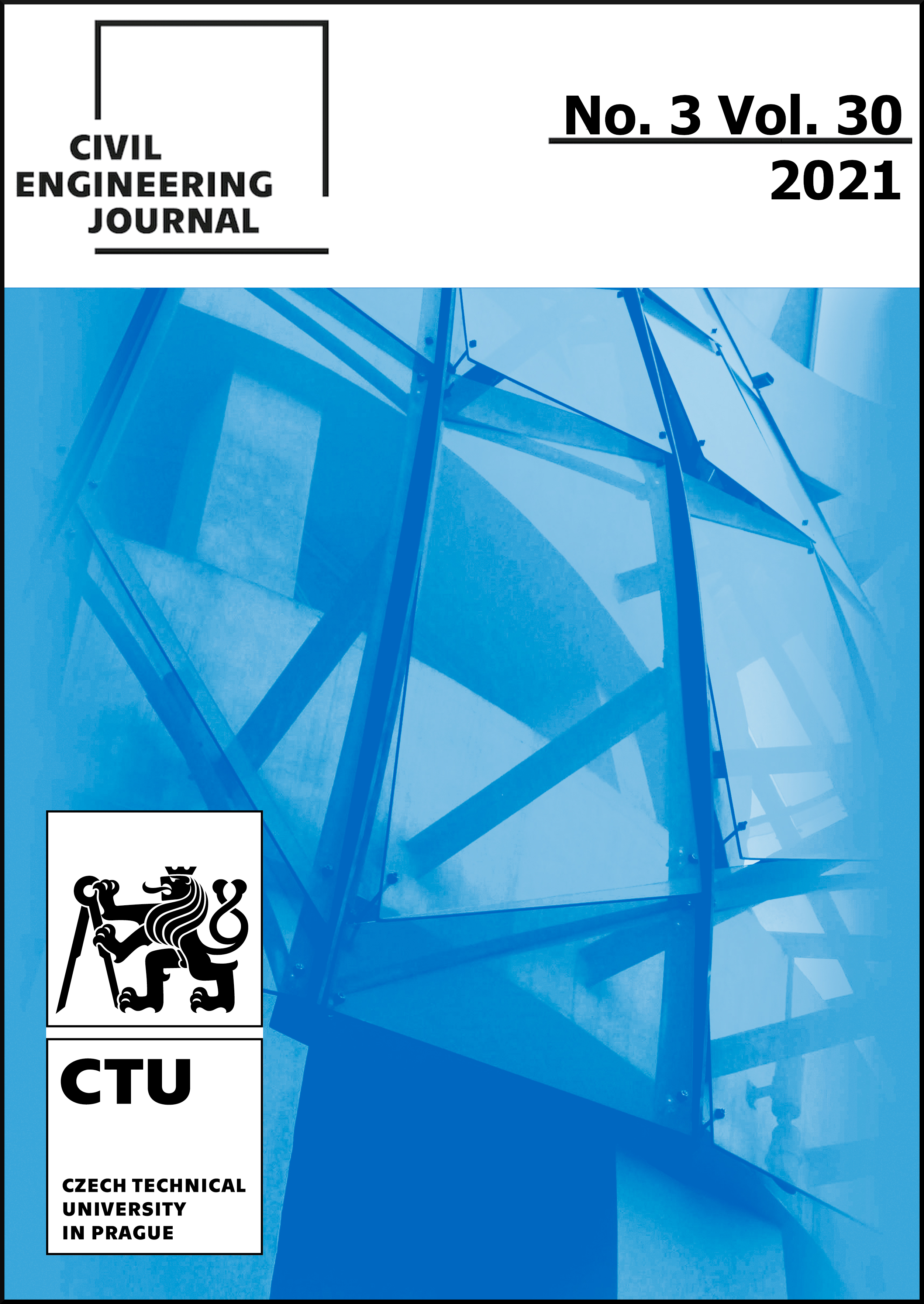FREE STATION TASK WITH DRONE
DOI:
https://doi.org/10.14311/CEJ.2021.03.0057Keywords:
free station task, drone, precision analysisAbstract
Using drones with different purposes than only taking photos is nowadays the main direction of drone development. Drones are made for package delivery, people transport, etc. Drone equipped by GNSS RTK and prism can be used as orientation point for the free station. The idea is using drone to get coordinates of total stations inappropriate for GNSS. such as high buildings and forest. The drone can fly above the obstacle causing inappropriate, so the GNSS will compute the position coordinates correctly. Total station will measure distance and angles on prism to get free station coordinates. This article deals with the accuracy of using two points in the free station task. Accuracy of measurement and data is based on real values. Drone can be used as the target if it is not windy, the position accuracy of the target on drone is 5 cm. Wind has no effect on the vertical position accuracy of the the drone. The results show that the same principles and limitations must be observed when measuring the free station task. Horizontal angle between orientation points must be bigger than 100 gon and the zenith angle must be at least 50 gon. The distance between orientation and free station must longer than consequent measured points.
Downloads
References
Štroner, M. - Hampacher, M.: Zpracování a analýza měření v inženýrské geodézii. 1. vyd. Praha: CTU Publishing House, 2011. 313 s. ISBN 978-80-01-04900-6.
Štroner, M.: K přesnosti volného stanoviska. Geodetický a kartografický obzor. 2012, roč. 58, č. 8, s. 170-176. ISSN 0016-7096
Annan, Richard & Yevenyo Ziggah, Yao & Ayer, John & Amans, Christian. (2016). ACCURACY ASSESSMENT OF HEIGHTS OBTAINED FROM TOTAL STATION AND LEVEL INSTRUMENT USING TOTAL LEAST SQUARES AND ORDINARY LEAST SQUARES METHODS. Geoplanning: Journal of Geomatics and Planning. 87. 87-92. 10.14710/geoplanning.3.2.87-92.
Andrew Marshall, Analysis of free station errors, Surv431 Engineering Surveying at the National School of Surveying in 2007
Sikola,J. Testing GNSS module Ublox 9 generation, Master’s Thesis,2020,http://hdl.handle.net/10467/88561
Jimenez-Cano, A.E.; Sanchez-Cuevas, P.J.; Grau, P.; Ollero, A.; Heredia, G. Contact-Based Bridge Inspection Multirotors: Design, Modeling, and Control Considering the Ceiling Effect. IEEE Robot. Autom. Lett. 2019, 4, 3561–3568. [Google Scholar] [CrossRef]
SUZUKI, Takayuki; KUMAGAI, Taichi; YOSHIDA, Hiroshi. Accuracy evaluation of drone control system using total station. IEICE Technical Report; IEICE Tech. Rep., 2020, 119.461: 67-72.
DELGADO, Javier Prada, et al. Bridge mapping for inspection using an UAV assisted by a total station. In: Iberian Robotics conference. Springer, Cham, 2017. p. 309-319.
MAXIM, Artyom, et al. UAV Guidance with Robotic Total Station for Architectural Fabrication Processes. Unmanned Aerial Vehicles; Wißner-Verlag: Augsburg, Germany, 2017, 145-161.
ISHII, A., et al. Autonomous UAV flight using the Total Station Navigation System in Non-GNSS Environments. In: ISARC. Proceedings of the International Symposium on Automation and Robotics in Construction. IAARC Publications, 2020. p. 685-692.
HANKUS-KUBICA, Agnieszka, et al. Verification tests of total station usability for UAV position measurements. In: 2020 IEEE 7th International Workshop on Metrology for AeroSpace (MetroAeroSpace). IEEE, 2020. p. 331-335.
STEMPFHUBER, W.; BUCHHOLZ, M. A precise, low-cost RTK GNSS system for UAV applications. Proc. of Unmanned Aerial Vehicle in Geomatics, ISPRS, 2011.
BLÁHA, Maroš, et al. Direct georeferencing of UAVs. In: Proceedings of the International Conference on Unmanned Aerial Vehicle in Geomatics (UAV-g). Copernicus, 2011. p. 131-136.
GUPTA, Sharad Kumar; SHUKLA, Dericks P. Application of drone for landslide mapping, dimension estimation and its 3D reconstruction. Journal of the Indian Society of Remote Sensing, 2018, 46.6: 903-914.
TIWARI, Nidhi P., et al. Advanced techniques used in surveying: total station, GPS, GIS, DRONE Arial survey. International Journal for Research in Applied Science and Engineering Technology, 2018, 6.3: 896-902.
CivDot, https://www.civrobotics.com/
GNSS UBlox CEJ
Downloads
Published
Issue
Section
License
Copyright (c) 2021 Stavební obzor - Civil Engineering Journal

This work is licensed under a Creative Commons Attribution-NonCommercial 4.0 International License.
Authors who publish with this journal agree to the following terms:
- Authors retain copyright and grant the journal right of first publication with the work simultaneously licensed under a Creative Commons Attribution License that allows others to share the work with an acknowledgement of the work's authorship and initial publication in this journal.
- Authors are able to enter into separate, additional contractual arrangements for the non-exclusive distribution of the journal's published version of the work (e.g., post it to an institutional repository or publish it in a book), with an acknowledgement of its initial publication in this journal.
- Authors are permitted and encouraged to post their work online (e.g., in institutional repositories or on their website) prior to and during the submission process, as it can lead to productive exchanges, as well as earlier and greater citation of published work (See The Effect of Open Access).
How to Cite
Accepted 2021-10-23
Published 2021-10-25










